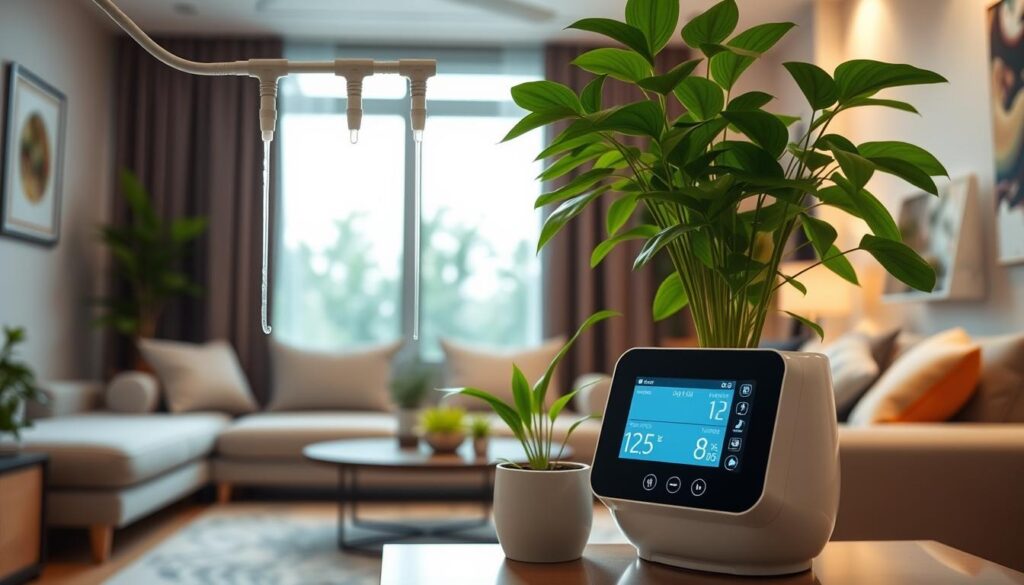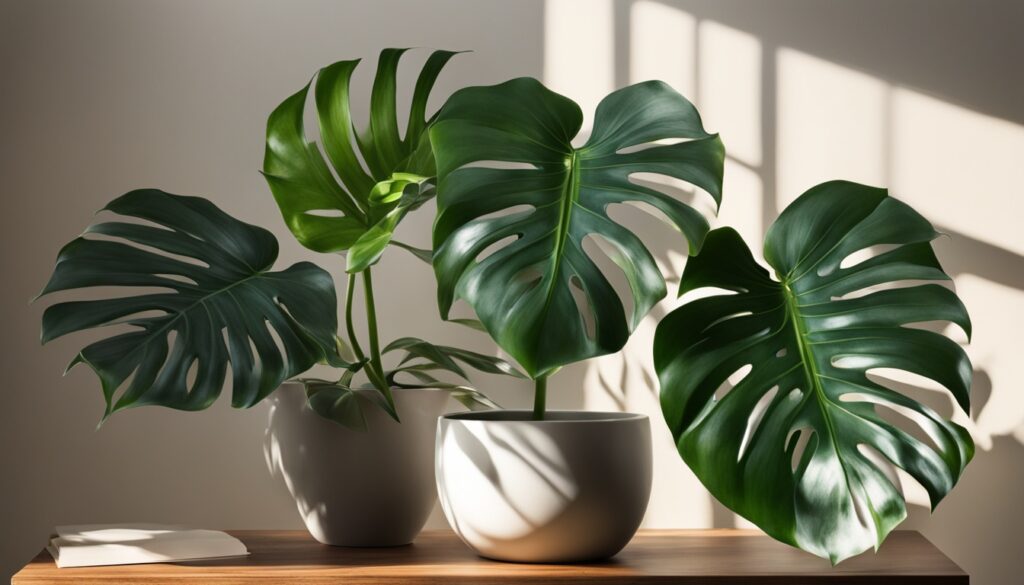Our lives are busy, and taking care of indoor plants can seem hard. But, what if you could automate plant care? This way, your plants get the right water, even when you’re not around. Welcome to indoor watering systems, a game-changer for houseplant care.
Is an automated watering system what you’ve been dreaming of? Learn how this tech can be a game-changer for plant lovers.
Key Takeaways
- Automated watering systems ensure consistent, reliable plant care even when you’re away
- Smart sensors and customizable timers allow you to tailor the watering schedule to each plant’s unique needs
- Integrated moisture monitoring helps prevent over-watering and root rot
- Sleek, compact designs seamlessly integrate into any indoor space
- Enjoy a thriving, low-maintenance indoor garden with minimal effort
Understanding Automated Plant Watering Systems
The world of indoor gardening has seen a big change towards hydroponic gardening. Water-based plant cultivation is now very popular. Automated watering systems have become a big help, making it easier to care for many plants.
Types of Automatic Irrigation Systems
Two main automatic watering systems are the Sancruz IC205S and the Onsast AUTO01. The Sancruz IC205S has a 400 ml per minute pump and 32.8 feet of tubing. It also comes with 15 drip stakes.
The Onsast AUTO01 has an 800 ml per minute pump and 24 feet of tubing. It has 12 adjustable drippers.
Benefits of Smart Plant Care
Automated watering systems save time and effort. They help keep plants healthy. These smart irrigation system solutions give plants the right amount of water.
By doing this, they prevent plants from getting too much or too little water. Water-based indoor plants do well in this setup. This makes any room look better.
Key Components and Features
These systems have a water reservoir, a pump, and tubing with drippers or stakes. The Sancruz IC205S has a simple timer. The Onsast AUTO01 needs more complex setup.
Both systems need careful setup to work well. This ensures plants get the right amount of water.
| Feature | Sancruz IC205S | Onsast AUTO01 |
|---|---|---|
| Pump Capacity | 400 ml/min (13.5 oz) | 800 ml/min (27.1 oz) |
| Tubing Length | 32.8 feet | 24 feet |
| Drippers/Stakes | 15 non-adjustable | 12 adjustable |
| Price | $30 | $13.50 (25% discount) |
“Automated watering systems not only save time and effort but also contribute to the overall health and well-being of indoor plants.”
Why Traditional Plant Watering Methods Fall Short
Keeping an indoor garden lush and healthy is hard, especially watering. Traditional ways like watering each pot by hand don’t always work. They can lead to too much or too little water, and even pests.
Manual watering can be tricky, especially with many plants or when you’re away. Plant watering devices that control moisture can help a lot. They make sure each plant gets just the right amount of water.
- Up to 70% water savings can be achieved compared to conventional methods by using drip irrigation systems.
- Smart irrigation systems that adjust watering schedules based on weather, soil conditions, and plant requirements are gaining popularity.
- The soil should be allowed to partially dry out between thorough waterings to foster deep root growth, making plants more drought-tolerant.
Too much water can harm plants, causing nutrient loss and diseases. Not enough water can make them weak and attract pests. Advanced precision irrigation technologies, such as automated drip systems with moisture sensor-based controls, help sustain plant health while reducing water wastage.
Using indoor garden irrigation solutions makes watering easier. It keeps the soil moist and helps plants stay healthy. With the right systems, watering becomes simple, letting you enjoy your indoor garden more.
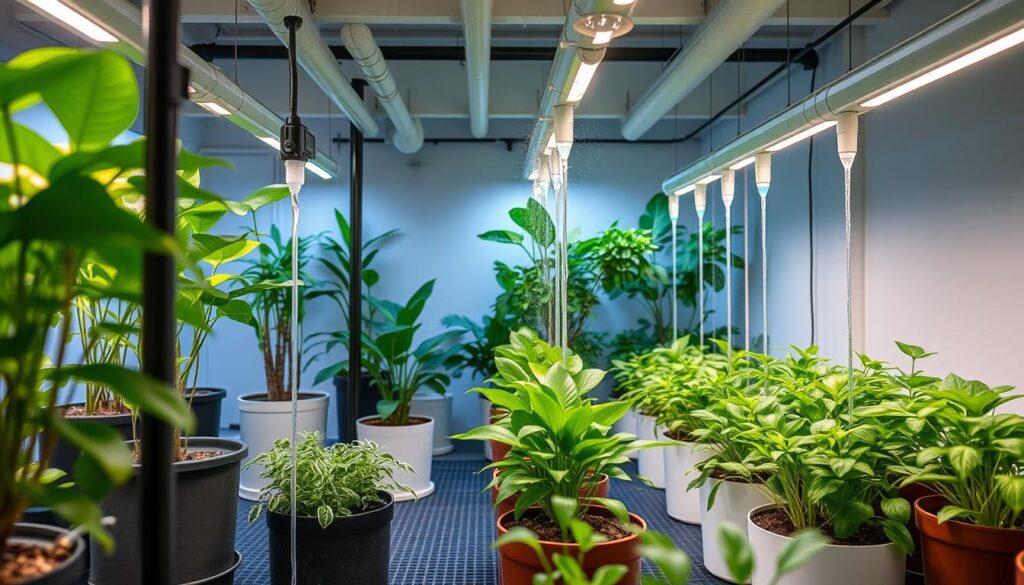
Indoor Watering System for Plants: Essential Components
Setting up an indoor watering system for your plants involves several key parts. These parts work together to keep your plants hydrated. You’ll need water reservoirs, pumps, control units, and timers to automate plant care.
Water Reservoirs and Containers
The water reservoir is the heart of your system. You can choose from 5-gallon Hedpak cubes or sturdy buckets. Pick a size based on how many plants you have and their water needs. This ensures your plants always have enough moisture.
Pumps and Distribution Systems
A reliable pump is needed to move water to your plants. You might choose a jet pump or a submersible pump. For example, the Sancruz system uses a 400 ml/min jet pump. The Onsast has an 800 ml/min submersible pump. These pumps send water through tubing, drippers, and stakes for even watering.
Control Units and Timers
Control units with timers are key for automating watering. They let you set watering schedules. This ensures your plants get the right amount of water at the right time. Some units even have humidity sensors to adjust watering based on the environment.
Placing these components correctly is vital for your system’s success. It helps your plants get the consistent hydration they need to grow well.
| Product | Water Output | Features |
|---|---|---|
| Blumat Universal Bottle Adapter with Watering System | 200 ml/24h | Fits most plastic bottles, for indoor and outdoor use |
| Blumat Supply Hose | N/A | Available in black and white, accommodates up to 250 droppers, 10m length, 8mm diameter |
| Blumat Drip Hose with Mini Branch & Mini Connector | N/A | Made of silicone, designed for individual pots and adapters |
| Blumat Universal Bottle Adapter with Ceramic Cone XL | 300 ml/24h | Fits almost any plastic bottle, for indoor and outdoor use |
“The Blumat Shut Off Valve is described as a reliable system made from sturdy material, and the Blumat Branch & End Distribution Dripper is particularly strong and durable.”
Selecting the Right System for Your Indoor Garden
Choosing the right indoor watering system for plants is crucial. Consider your plants’ needs, the features you want, and your budget. These factors help pick the best automatic plant watering solution for you.
The Sancruz system is simple with fixed drippers for consistent watering. The Onsast system, however, has adjustable drippers for more customization. This lets you adjust water flow for each plant’s needs.
For advanced features, look at systems with humidity sensors or WiFi. These smart systems adjust watering based on the environment. They also let you control your garden from your phone or tablet.
| System | Key Features | Pros | Cons |
|---|---|---|---|
| Sancruz Indoor Watering System | – Fixed drippers – Simple setup |
– Consistent water supply – Budget-friendly |
– Less customization options |
| Onsast Indoor Watering System | – Adjustable drippers – Customizable water flow |
– Tailored to plant needs – Flexible setup |
– Higher initial investment |
When picking an indoor watering system, think about your plants, desired features, and budget. The right system ensures your plants get the care they need to thrive.
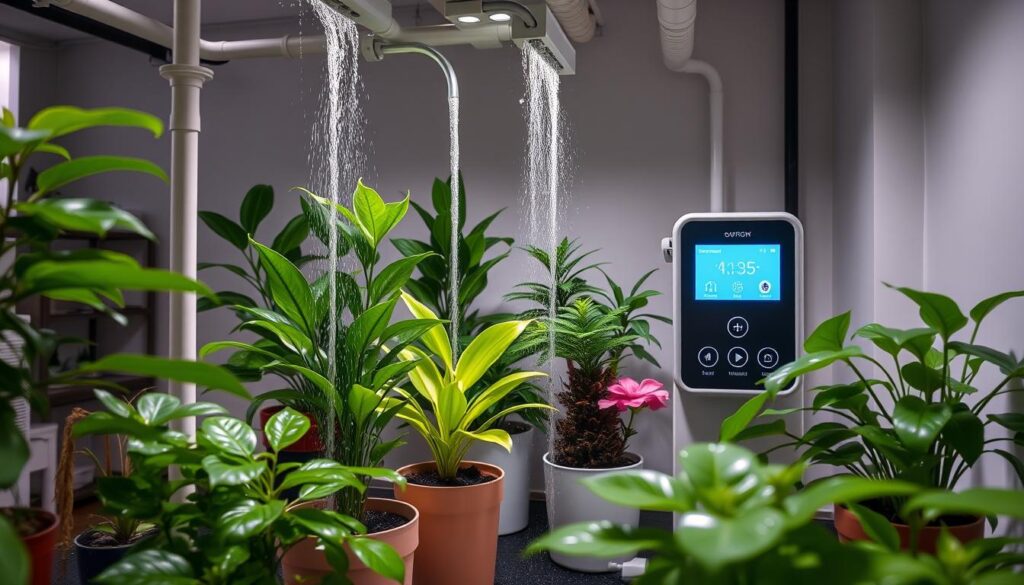
Smart Sensors and Moisture Monitoring Technology
Smart sensors and moisture monitoring technology are key to any advanced indoor watering system. They offer precise and automated plant care. At the center are capacitive moisture sensors that measure soil moisture levels accurately. This lets the watering system respond correctly.
These sensors detect soil moisture using electrical capacitance. They send real-time feedback to the control unit. With LED indicators and digital displays, gardeners can track soil hydration easily. They can then decide when to water.
Capacitive Moisture Sensors
The Sancruz smart irrigation system has a built-in moisture sensor for plants. It uses capacitive technology to measure soil moisture. This sensor checks the soil constantly and talks to the control unit. It makes sure the smart irrigation system waters only when it’s needed.
- Accurate soil moisture measurements using electrical capacitance
- Real-time data transmission to the control unit
- Adaptive watering schedules based on actual soil conditions
LED Indicators and Digital Displays
The Sancruz system also has LED indicators for visual feedback. A flashing red light means the soil is dry. A steady green light shows it’s moist enough.
The system’s digital displays show a lot of information. This includes current moisture readings, watering schedules, and system settings. It helps gardeners make smart choices and manage their indoor watering well.
“The ability to monitor soil moisture levels in real-time is a game-changer for indoor gardeners, allowing them to optimize watering and ensure the health of their plants.”
Installation Guide: Setting Up Your Watering System
Setting up an automated indoor watering system is easy and saves time. It keeps your plants healthy and green. You can use drip irrigation kits or a DIY wick system. The key is to place everything right and connect it correctly.
Positioning the Control Unit and Water Reservoir
First, put the control unit above the water reservoir. This makes watering your plants efficient. Make sure it’s mounted well and easy to reach for adjustments.
Connecting the Tubing
Measure and cut the tubing for your plants’ layout. Connect it to the control unit and then to the plants. Use T-connectors for bigger gardens to reach more plants.
Adjusting Drippers and Stakes
Place drippers or stakes in the right spot in your pots. Adjust the water flow for each plant’s needs. Some plants need more water than others.
| Dripper Type | Flow Rate Range | Suitable Applications |
|---|---|---|
| Shrubbler Adjustable Dripper | 0-40 LPH | Gentle watering for small plants |
| Mini Bubbler | 0-120 LPH | Trees, shrubs, and larger plants |
| Pressure Compensating (PC) Dripper | 2, 4, 8 LPH | Consistent flow regardless of pressure variations |
Make sure the tubing is well-placed to avoid upsetting your plants. This keeps your setup stable and secure.
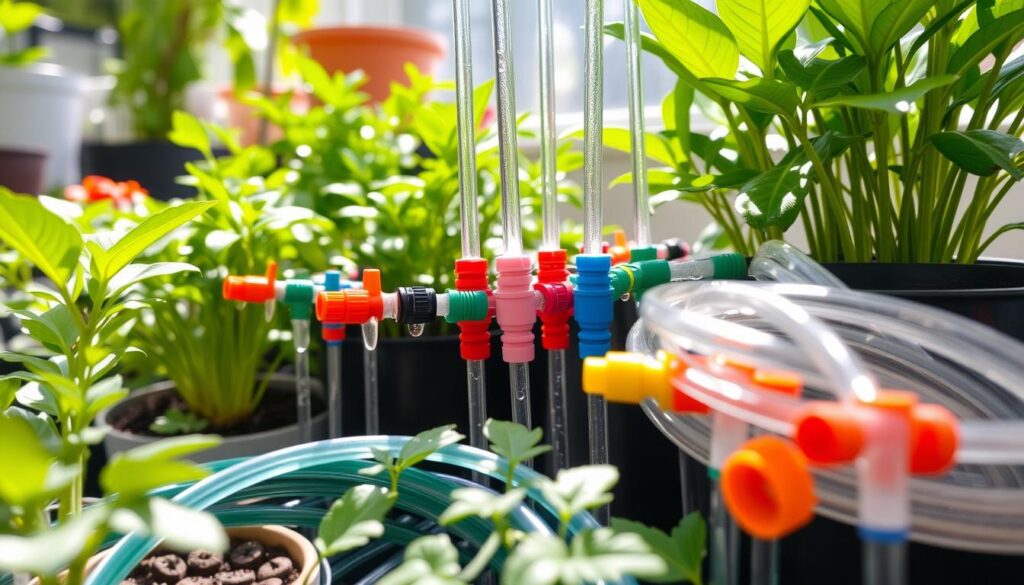
DIY Wick Watering System
A DIY wick system is simple and easy to care for. Use a water reservoir and cotton shoelaces as wicks. Soak the shoelaces and place them in the soil.
Plan your wick system based on your plants and space. Use the right number of wicks and a big enough reservoir. Make sure the soil is right for the water to wick up well.
Programming and Timer Settings for Optimal Watering
Getting the right balance for your plants and water starts with your water timer for plants or smart irrigation system. These tools let you adjust watering times, lengths, and start-ups for your indoor garden. This way, you can meet your plants’ specific needs.
Scheduling Basics
Start by setting how often and for how long you water. Many systems have simple controls and clear displays. Just press the plus and minus buttons to change the schedule. For more complex systems, it might take some getting used to, but it’s still easy.
Custom Water Distribution Settings
As your garden grows, some spots might need more or less water. Use custom settings to give each area the right amount. Watch your plants and tweak the settings to make your smart irrigation system work best.
“Proper programming and timer settings are the keys to unlocking the full potential of your indoor watering system. With a little experimentation, you’ll be able to create a tailored watering schedule that keeps your plants thriving and your water bills in check.”
Water Pressure and Flow Rate Optimization
Getting the right water pressure and flow rate is key for watering your indoor plants well. Using a drip irrigation kits or an indoor watering system helps a lot. This ensures your plants get the moisture they need for healthy growth.
Choosing the right drippers is important. Adjustable drippers, like those in the RAINPOINT IK10P-UK model, need careful pressure balancing. Fixed-rate drippers, like in the MIXC Irrigation System, make things easier by keeping water flow steady, no matter the pressure.
- Adjust the flow rate and pressure to match your plants’ needs. Big plants might need more than one dripper for enough water.
- Fix air bubbles in the tubing by tweaking the dripper valves and pump runtime. This helps water flow better.
| Specification | Value |
|---|---|
| Water pressure range | 0.5 bar to 8 bar (7-116 PSI) |
| Flow rate variability | 5 l/min to 35 l/min |
| Manual watering time range | 1 min to 60 mins |
| Automatic watering time range | 1 min to 11 hrs 59 mins |
| Watering range | up to 60 m |
| Operating temperature range | 3 °C to 50 °C |
By optimizing water pressure and flow, your drip irrigation kits or indoor watering system for plants will water your plants efficiently. This leads to lush, healthy growth and vibrant leaves.
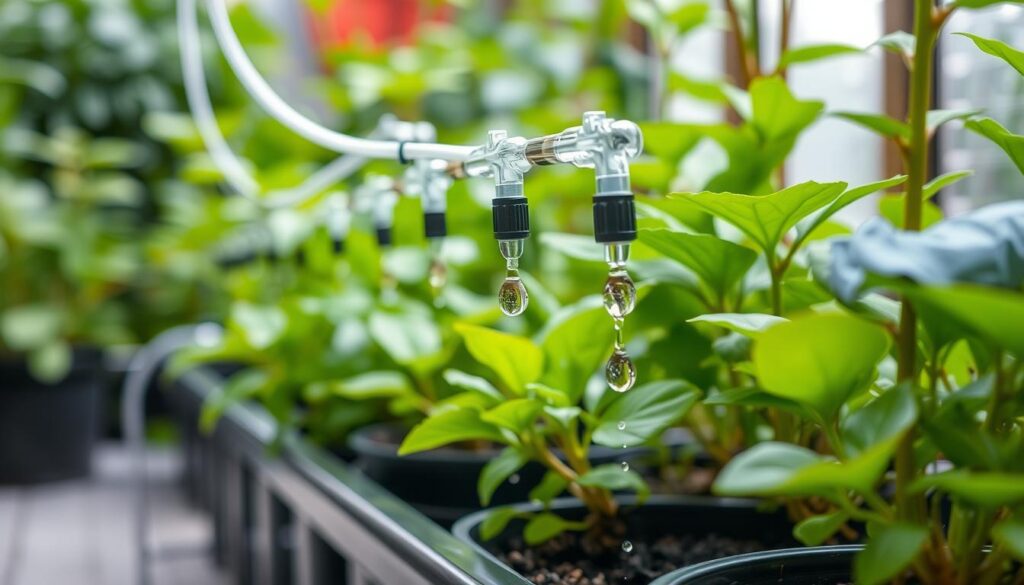
“The indoor watering system has been a game-changer for my plant care routine. With its adjustable settings and reliable performance, I can now keep my plants thriving all year round, even in the driest indoor environments.”
Maintenance and System Care Guidelines
Keeping your automatic plant watering system in top shape is key for your indoor garden’s health. Regular cleaning and quick troubleshooting are vital. This ensures your automatic plant watering system works well, giving your houseplants the water they need.
Regular Cleaning Procedures
To keep your indoor garden irrigation system running smoothly, regular cleaning is a must. This includes:
- Clearing any debris or buildup in the water reservoirs and containers
- Inspecting and cleaning the pumps and distribution tubing to prevent clogging
- Removing mineral deposits or scale from drippers and emitters
Troubleshooting Common Issues
Even with regular care, your automatic watering system might face some problems. Watch out for and fix these common issues:
- Uneven water distribution: Check for any blocked or clogged drippers, and ensure proper water pressure and flow rate throughout the system.
- Air bubbles in the tubing: Inspect for leaks or loose connections that may be allowing air to enter the system.
- Malfunctioning moisture sensors: Replace sensors periodically as they can become less accurate over time due to exposure to soil minerals.
| Issue | Troubleshooting Steps |
|---|---|
| Uneven Watering |
|
| Air Bubbles in Tubing |
|
| Malfunctioning Moisture Sensors |
|
By keeping up with maintenance and fixing problems quickly, your automatic plant watering system will keep your indoor garden well-watered. This ensures your plants thrive in their indoor home.
Energy Efficiency and Power Source Options
Choosing the right power source for your indoor watering system for plants is key. Smart irrigation system designs offer various power options. This lets you pick what works best for you.
Systems like the Sancruz use rechargeable lithium-ion batteries or USB-C. This makes them easy to move around in your garden. The Onsast system, however, uses a wired 12-volt DC supply. It gives a steady power source for your smart irrigation system.
The energy use of your system also depends on the pump and how often it runs. Using efficient pumps and smart watering times can cut down energy use. This saves money and helps the environment.
| Power Source Option | Energy Efficiency Considerations |
|---|---|
| Rechargeable Batteries |
|
| Wired 12V DC Supply |
|
By picking the right power source and making your indoor watering system for plants energy-efficient, you can save money. You also help the planet.
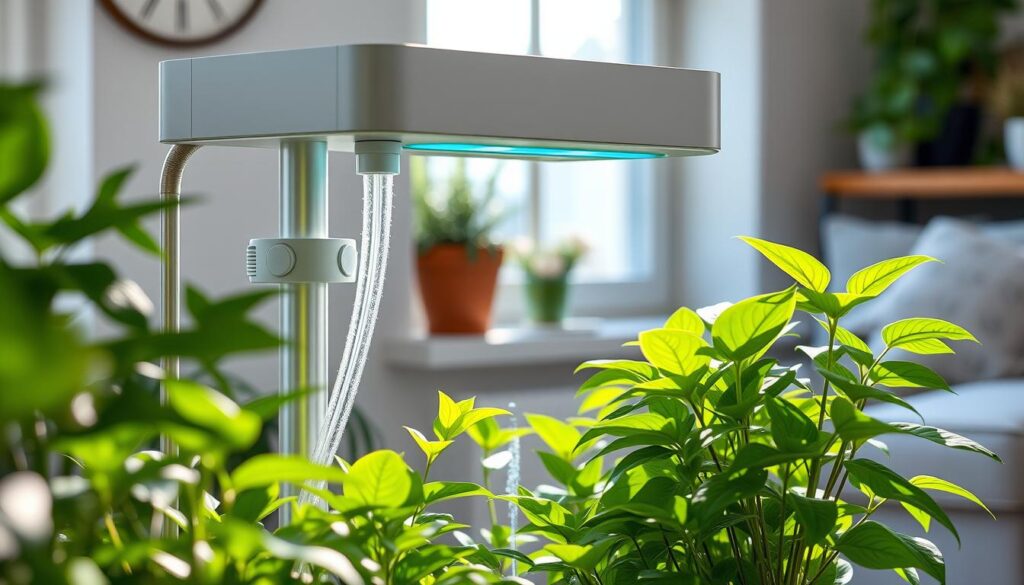
“Investing in an energy-efficient smart irrigation system not only saves you money on utility bills but also contributes to a more sustainable future for our planet.”
Advanced Features: WiFi Control and Smart Home Integration
Technology keeps getting better, and so do indoor watering systems for plants. Now, many smart irrigation systems have WiFi. This lets users control and check on their plants from anywhere using mobile apps.
Mobile App Controls
With WiFi, you can change watering schedules and check plant health from your phone. Mobile apps make it easy to manage your system. They also track water use and let you set custom settings for your plants.
Smart Home Compatibility
Connecting smart irrigation systems to home automation platforms makes plant care even better. You can link them to smart speakers or voice assistants. This lets you control your plants with just your voice.
These advanced features are convenient but might cost more. Think about what you need and if the extra cost is worth it for your indoor garden.
“The ability to control my indoor watering system from anywhere has been a game-changer. I can now easily adjust schedules and monitor my plants, even when I’m away from home.”
– Avid Indoor Gardener, Sarah Johnson
Best Practices for Different Plant Types
Creating a great indoor garden needs a plan for each plant type. Adjust your watering system to meet their needs. This ensures your garden gets the right moisture and nutrients.
Group plants by their water needs when setting up your system. This way, you can water each group right, not all the same. Think about pot size, plant size, and growth stage for the best watering schedule.
Watching your plants closely is key to a good indoor garden irrigation system. Check leaves, stems, and soil moisture. Adjust your system if you see signs of too much or too little water. This way, your plants get the perfect water balance.
| Plant Type | Watering Needs | Recommended Settings |
|---|---|---|
| Succulents and Cacti | Prefer drier conditions and infrequent watering | Longer intervals between watering cycles, lower flow rates |
| Orchids | Require their roots to dry out between waterings | Avoid self-watering systems, opt for manual watering |
| Small Potted Plants | Dry out quickly, need more frequent watering | Shorter intervals between watering cycles, higher flow rates |
| Large Potted Plants | Retain moisture for longer periods | Longer intervals between watering cycles, lower flow rates |
Customize your plant watering devices for your plants. This makes your indoor garden healthy and easy to care for.
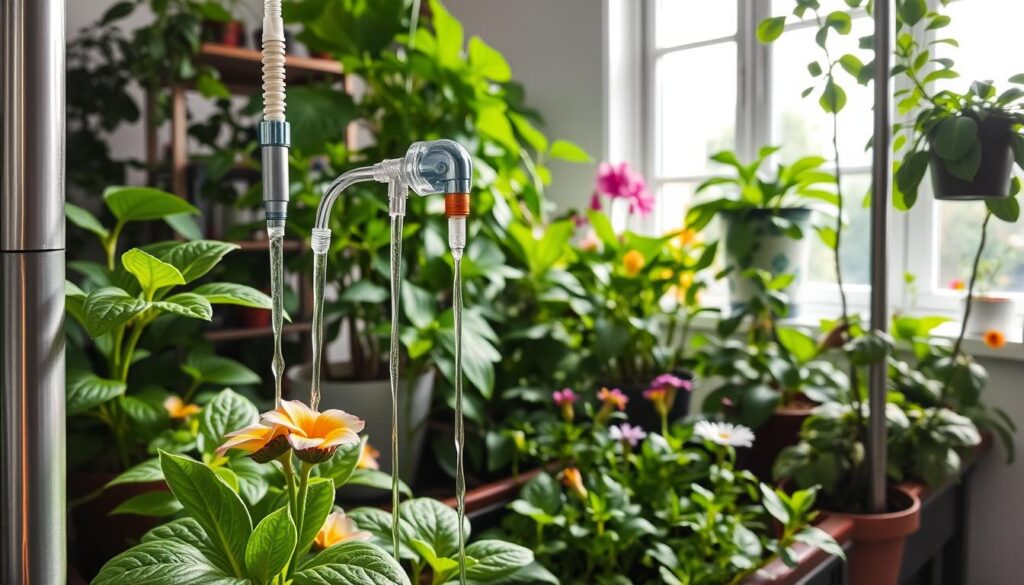
Cost Analysis and Long-term Benefits
Buying an indoor watering system for plants might seem expensive at first. But, the long-term gains often make it worth it. When looking at the costs of an automatic plant watering system, think about both the initial cost and the future savings.
Initial Investment Considerations
The price of an indoor watering system varies a lot. It can start at $13.50 for a simple setup or go up to $50 for a more complex one. The size of your garden, the system’s complexity, and any smart features can affect the price.
Even though the initial cost might seem steep, remember the long-term savings. An automated system can cut down on water use, reduce plant loss, and save you time on watering.
Return on Investment Calculations
When figuring out the ROI of an indoor watering system, consider these benefits:
- It keeps your plants healthy while you’re away, avoiding the need for new plants.
- It uses less water, which can lower your bills over time.
- It saves you time on watering, letting you do other things.
- It can last for years, with parts like sensors and pumps lasting a long time.
By comparing the initial cost to the long-term savings and benefits, you can see if an indoor watering system is right for you. This helps you make a choice that fits your gardening needs and budget.
| Cost Comparison | Hydroponic System | Traditional Gardening |
|---|---|---|
| Initial Investment | $300 – $4,000 | $50 – $200 |
| Water Usage | Lower water consumption | Higher water consumption |
| Electricity Costs | Higher due to equipment | Lower |
| Crop Yields | Higher due to controlled environment | Lower and more variable |
| Labor Costs | Higher for monitoring and maintenance | Lower for manual gardening |
Understanding the cost and long-term savings helps you decide if an indoor watering system for plants and automatic plant watering is right for you. It’s about finding the best fit for your needs and budget.
Safety Considerations and Water Management
Setting up an indoor garden irrigation system requires careful attention to safety and water management. Make sure all electrical parts, like pumps and control units, stay away from water. This prevents short circuits and electrical shocks. Use the right voltage for your pumps and add resistors if needed for safety.
To stop water spills or flooding, use water-resistant mats or trays under your plants. Keep an eye on how much water your plants use to avoid overwatering. Overwatering can cause root rot, fungal growth, and damage to floors or furniture. Check for leaks or water overflow often and fix them quickly to keep your garden safe and healthy.
By focusing on safety and managing water well, your indoor garden irrigation system will work efficiently and safely. This helps keep your plants healthy and thriving.
